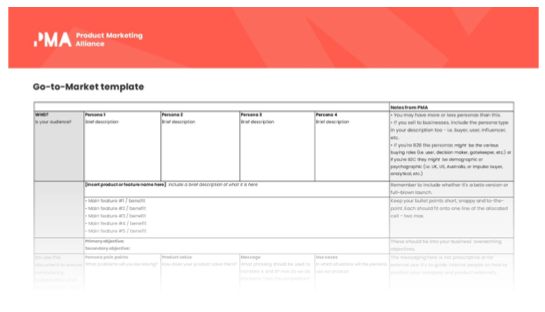Measuring the success of a launch can be challenging. From attribution, adoption, and consumption metrics, to 30, 60, 90-day revenue targets, these data points of success are not the easiest to come by and oftentimes, they can be difficult to capture.
Carter Holland, Market Strategist at GhostRetail, has 25 years of experience leading large-scale marketing teams and shares his insights on how product marketers can measure the success of their product launches and optimize the launch process.
We’ll focus on various topics, including:
- Product marketing goals and KPIs
- Why product differentiation is important
- Important KPIs and metrics when launching a new product
- How to work with product management teams
- The role of qualitative metrics in product launches
Product marketing goals and KPIs
Q: The PMM function often sits within marketing. What goals and KPIs do you hold a product marketing team accountable for?
A: “The number one goal is revenue. Product marketing needs to be accountable for product revenue associated with adoption by new users, like net-new logos, upsells, and cross-sells. Without a revenue focus, product marketing is more words and analysis but it needs to be done on purpose.
“Then there's a set of KPIs that I always look for - they’re the health indicators of whether or not you're going to hit your goal. So if revenue is the goal, KPIs feeding into that can be qualitative and quantitative.
“However, to hit the revenue goal, you've got to have a clear map of the target users where you get into personas and use cases, and pain points for each of the personas.
“In many businesses, there's also a layer of business archetypes, where you have different flavors of the business where the pain points and use cases may differ and vary from business to business. Archetypes are another key component and having that well documented is a qualitative KPI.
“In terms of competitive strengths, weaknesses, and kill points, having a strong messaging framework designed to address all of the above is another key KPI because you can't put great influencing messaging together if you don't have that kind of framework in place. It's that kind of influencing messaging that's going to drive customers to make purchases.
“Therefore, I think if I had to be more specific around KPIs, I'd probably say product marketers should focus on win rates and compare these figures against their competitors, as well as internal solutions. Sometimes companies don't buy a competitor, they build it themselves - you need to consider ways in which you’ll position yourselves against that internal solution.
“Looking at the win rates in both of those categories, that's a top KPI to understand if you're gonna hit your revenue targets. The product usage rates are also important to understand the core capabilities that correlate with adoption by new logos, as well as retention.
“Then, you need to consider the materials product marketing is creating, which materials are being used. For example, what’s being used by sales? You need to show evidence of how they’re shortening the sales cycle and whether they’re resonating with customers and getting prospects to make buying decisions faster.
“Those are ways to quantify metrics that can help indicate whether you're going to be on track for hitting revenue goals.”
In highlighting the role of metrics in the product launch process, Carter alludes to the role of metrics in product marketing itself - but the process isn’t always easy. Adobe's Group Manager, PMM, Mary Sheehan, acknowledged the challenges PMMs can face when collecting insights:
"Industry experts often describe measurement as an integral part of product marketing, yet many of us struggle with presenting metrics in a way that will actually impact the business. Whether you’re just tracking a launch, working with a longer sales cycle, or managing up-sell and cross-sell, measurement can be daunting.”
Why is product differentiation important?
Differentiating your product sets it aside from the competition and provides your target personas with a distinct reason to opt for your company - if competing products aren’t offering the same features, where else can they go?
Add to that, exclusivity provides you with a basis to introduce higher price points. Curiosity and consumers go together like hand in glove. If you’re bringing a niche product to market, the chances are consumers will be willing to spend more cash to experience something that’s different from everything else.
Carter Holland explains why product differentiation is important for product marketers, and in business, generally:
Q: As far as adoption metrics are concerned, how has the role of a product marketer changed the way you as a marketing leader look at new user adoption campaigns versus existing customers and consumer adoption?
A: “I’ve managed product marketing, but my background in marketing and rising to market leadership stems from communications.
“Therefore, I bring a lot to the table as far as the differentiated position is concerned and establish how that impacts effectiveness when it comes to things like user adoption and consumption.
“Differentiation is critical. Last night, I was watching Shark Tank, and there was this product called the X Torch. It’s a multi-purpose flashlight - you can use it in a bunch of different ways as a USB charger, and so on.
“At one point, Mark Cuban borderline dismissed the product and said: “It's a flashlight”, and the owner pitching the product was emphatic and replied: “This isn’t just a flashlight - it's the only rechargeable, solar-powered lantern that's also a phone charger that you can count on when the power goes out. Mark Cuban replied: “Otherwise known as a flashlight…”
“The point of this story is you have to be able to differentiate your product from others that are available on the market, and people who know me say I’m like a broken record because I always maintain you need to differentiate products in a way nobody else can.
“Articulate how your product addresses a pain point and closes a gap in the market. People are trying to be successful in their jobs, and if something is impeding that success, that's creating pain for them. Our ability to describe the pain that they're feeling, and then say, ‘here's how that pain can be eliminated and you can’t eliminate it without using something else’ is critical.
“I think this applies to new customer adoption as well as consumption. If you're trying to emphasize how a product can be used for an existing audience, it's a matter of drilling in those points. Marketers get lost in jargon that nobody understands - you need to be human.
“In the same way that we forget there's a revenue goal behind what we're doing, I think we forget that there's a human being on the other end of the buying process.
“If we can relate to people on a human level using terms they’ll understand, I think success will follow because they’ll clearly understand how our solution addresses their issue. I think we will be surprised at how we could accelerate adoption.”
It’s natural for companies to try their utmost to differentiate themselves from the competition - but what do you do if you’re truly struggling to set yourself apart from market alternatives?
Lawson Abinati, Co-Founder of Messages That Matter, explained how to differentiate yourself from your competition - even if you aren’t difficult, at all:

Which KPIs and metrics are important when launching products?
Q: Which KPIs and metrics are important to consider when focusing particularly on a product launch?
A: “I would say revenue. You'd be surprised how many times in my career I've asked teams what the revenue target is, only to be told they don’t know.
“If you don’t have an idea of how much revenue you’re looking to generate, what’s the point? If you don’t have the revenue forecast, you don’t need to abandon your product launch, the figures can be obtained, but you need to have a revenue goal.
“Dissecting that revenue goal can be important, too, and if you're a global business, the revenue goal should be regional. You need to consider how you’re going to work with local sales and marketing leaders on their business and pipeline objectives to understand how you can be impacting the launch in their region. Not every region is going to have the same part of the goal.
“We often think, ‘here are the four main selling propositions of this product’, and in a way, if we homogenize it too much like that, it may not work in every part of the world. That's not to say it's hypersensitive. For example, in Germany, it's maybe different than it is in the UK, and similarly, it’ll be different again in Illinois.
“However, across Europe in a certain business segment, there are very different pain points than you might have in the US in a different segment, and so at the end of the day, the product does what the product does, but it's being able to relate to the challenge that the market has. The regional piece relates to revenue goals, so I think it’s important. Again, that cascades to helping you and your team position the product.
“In my opinion, you win because you're going to help your customers do one of three things: make money, choose some sort of savings, the right time or cost, and reduce risk. As a quantifiable B2B metric, it comes down to those three things, almost everything else can probably be slotted into one of these.
“If we only say that we're faster or better without hard data, it doesn't mean anything. You can't say ‘tell your customer if they use your product they’ll grow their business faster, or save countless hours.’
“These are hollow comments; when you provide quantifiable results, you can't argue with the benefit. You can debate it, like whether it's good enough or not, but the data is substantive. You must have the specific quantifiable value that the product can deliver.
“For example, imagine a piece of tech that was going to automate a process. You need to say something along the lines of, ‘with automation, only one person has to be involved. They can set it up in thirty minutes, and the automated process is complete in two hours. A process that used to take three people two days to complete now takes two hours for thirty minutes of one person's time.’
“These data points have been used to justify the value and now you're hitting your core value pain point that the business understands - they know if they can save that amount of time, that there's an efficiency metric they can manage.
”However, if you're only telling them, ‘you can be more efficient if you use this product’, everybody's saying that, and you’ll find you’ll still be competing with everyone else because you’re not differentiating yourself.
“Those kinds of things are critical when you're launching any type of product. I think the challenge there is sometimes with a new product, we don't necessarily know what the quantifiable metrics are, so get the data points - I always test the product team and what data we have that we can refer to about performance.
“I think there are other things too, like, you know, who are we targeting in terms of competitors: how many competitors do we want to displace with this launch? There are things like objection handling that play key roles in product launches. And you also need to triangulate personas, geographic trends, and nuances there. I think those are critical in launching a product.”
How to work with product management teams
An effective working dynamic plays a crucial role in companies achieving their short and long-term goals, and product management and product marketing teams are by no means exempt from this rationale, with Rory Woodbridge, Head of Product Marketing at Pleo, highlighting how not to work with product managers if you're a PMM.
Carter Holland offered his perspectives on how PMMs can liaise effectively and work in unison with their PM peers:
Q: How can product marketers work with the product management team to identify relevant performance metrics relating to the end-user?
A: “I think it's worth being a little provocative and making the suggestion to challenge your product teams if they're not giving you the answer that's going to work for you.
“It’s the job of product to develop the solution, and it's the job of product marketing to take the product to market and communicate in a way that's going to matter to somebody who needs to buy it.
“Product teams are notorious for innovation. They develop capabilities and tell you about new features, and that's all great, but how do we know that this matters to the end-user? What conversations have they had that have highlighted the problem that we were told exists in this business?
“This is where you can start to uncover some of these conversations, and if they haven't done the final test, they might say to you: ‘look, we've been hearing in the field that it takes three people two days to get this thing done. This feature will offer them a way to get it done in two hours.
“From a marketing standpoint, you can take that to market in a quantifiable way. And hopefully, you can get that data from the product team. If you can't, and you're pushing on it, and they’re asking you to just trust them, don't settle for that. You need to push hard on it; you're going to be able to sell more of the product and make more money as a company if you’re able to quantify the value.
“It's been proven time and again - customers don't know how to choose if they're faced with five different things and nobody's quantifying any value. If four of them are generic, and one of them quantifies the value, which one do you think they're gonna buy?”
The role of qualitative metrics in product launches
Qualitative data is non-statistical and consists of impressions, opinions, and views. It’s generally used to answer ‘why’ questions are usually investigative, and often consists of open-ended questions.
Qualitative data can be generated through a range of sources, such as:
- Texts and documents
- Audio and video recordings
- Images and symbols
- Interview transcripts and focus groups
- Observations and notes
Qualitative research can provide an invaluable set of deep insights, but how exactly does it relate to the product launch process?
Q: Qualitative metrics are very valuable in product launches, but perhaps aren’t as concrete as quantitative metrics. Which qualitative metrics do you find valuable?
A: “Qualitative metrics help us when we’re taking a hard look at the messaging and positioning that we've put together.
“We do a diagnostic on what's working well, and what's not working well, and when we’re speaking to customers, we ask the product team to use these metrics to determine which message is resonating.
“This can be played out in multiple ways, such as the messaging and positioning of the solution, particularly in objection handling, which is a living and breathing process.
“Sales often comes in and says, ‘the product has been beaten up by this new company, or a new tool that's out there - here's what they're saying about us in their solution.’
“Product marketing develops some action points, and we go back out to market with them, and four of the ten points resonate while the other six don't. It’s important to get that information back into product marketing to understand what's working; if the other six aren't, what do we understand about that? Which ones need to be kicked under the curb? How can we refine them?
“This process is always going to be changing; sales will always have conversations, there's either going to be a new competitive entrant or there’ll be some form of a new entrant.
“This relates to competition, but the same is true of pain points, i.e. talking to customers. That said, in the case of product marketing, we often get buried in our internal work and we're not out there talking to customers enough. You need to have those conversations to source qualitative feedback to shape how you take a product back out to market.
“However, people don’t always think like that. Qualitative feedback comes from doing a survey, but it's also going to come if you're having conversations with personas, documenting their responses, and using the information to form the framework to put your position and your strategy together.”
How is product launch success defined?
Q: Is there a single leading metric that would define the success of a product launch?
A: “Revenue - you're always going to look at the financial success. You can say all the other things like cost, customer adoption, etc. but all those things should be leading to revenue.
“If you get customers to adopt it, and revenue isn’t associated with it then the business should be asking whether they’re focusing on the right thing, entirely. Therefore, in my mind, revenue is the single most important metric tied to a product launch.”

Aligning metrics with the sales cycle
Q: How is revenue measured in correlation with the sales cycle? Some sales cycles are much longer than 30 days, so there are low indicators of seeing that metric until months out. How might you look at that?
A: “I take a holistic view on the business and revenue to start. Before I ever get to any sort of product revenue, I look at the revenue for the business; I take it over a year, and say ‘if our year-over-year revenue growth is expected to be X, how does that break out by region and by product?’
“You need to ask how you’re triangulating that because that's where nuances come into play. Therefore, when you set a revenue goal for a product, it can have those nuances attached to it.
“We may say, in the first six months, we're expecting the adoption to be in the US only, and we're not going to push this in Europe yet. This decision would be based on what the market is telling us.
“You may find it’s split in a way that replicates how your business’s split, with 10% from Asia and 30%, from Europe and the rest, so you could try and break it out that way. That’s the way I tend to look at it.
“I think you want to sort of dovetail that with, ‘okay, when we look at all of our products, and the revenue there, how does that tie into the way we set up to run our business?’
“That’s a step that a lot of times people don't take because a lot of businesses take the peanut butter approach and say, ‘we're gonna launch this product worldwide, we're expecting $80 million in revenue - who knows where it's coming from? We’ll throw it all against the wall, and see what sticks.’
“You can be more successful if you've done the analysis upfront and say, ‘if we've got to generate $5 million or $10 million revenue for this product, 70% of that could come from APAC because here are the needs that are in that market and here are the needs this product addresses.’
“While I say revenue is the single leading metric, there's a lot more to that - there are sub-metrics underneath that. When you do that, it becomes actionable for the teams and everybody knows what their stake is. Then, when it comes to regional teams, you need to develop programs against that so they have clear markers in place.”
The importance of the post-launch process
While companies are often thorough when completing the stages up to a product being released, companies are sometimes guilty of neglecting the post-launch process, despite its importance to ensuring a product’s sustained success.
Menelaos Moustakas, Head of Marketing at SumUp, explains that while it may seem the work is done when the product is on the open market, this couldn’t be further from the truth:

Recommended tools for product launches
Equip your internal teams with resources that’ll streamline the process and enhance the overall quality of a product launch.
Sign up for a Product Marketing Alliance membership, unlock a variety of templates, and support your strategic initiatives.

And if you wanna take things even further, register for Go-to-Market Certified and refine your understanding of essential elements of the GTM process.
Delivered by Yoni Solomon, Chief Marketing Officer at Uptime.com, Go-to-Market Certified equips you with everything you need to design, launch, and measure an impactful strategy, and by the time you’ve finished the course, you’ll:
🚀 Grasp a proven product launch formula that’s equal parts comprehensive, repeatable, creative, and collaborative.
🧠 Gain the expertise and know-how to build and tailor an ideal product blueprint of your own.
🛠 Equip yourself with templates to facilitate a seamless GTM process.





